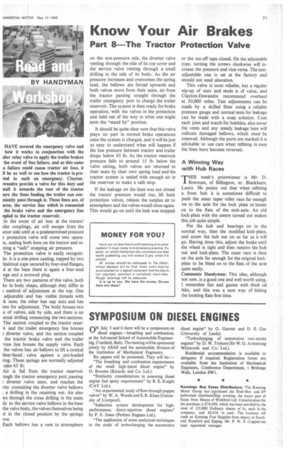Know Your Air Brakes
Page 73

If you've noticed an error in this article please click here to report it so we can fix it.
Part 8—The Tractor Protection Valve
on the non-pressure side, the diverter valve venting through the side of its top cover and the service valve venting through a small drilling in the side of its body. As the air pressure increases and overcomes the spring load, the bellows are forced upwards and both valves move from their seats, air from the tractor passing straight through the trailer emergency port to charge the trailer reservoir. The system is then ready for brake operation, with the valves in the protection unit held out of the way in what one might term the "stand by" position.
It should be quite clear now that this valve plays no part in normal brake operations once the system is charged, and it will be just as easy to understand what will happen if the line pressure between tractor and trailer drops below 65 lb. As the tractor reservoir pressure falls to around 15 lb. below the valve setting, both valves are returned to their seats by their own spring load and the tractor system is sealed with enough air in the reservoir to make a safe stop.
If the leakage on the lines was not closed the tractor pressure would rise, lift both protection valves, release the surplus air to atmosphere and the valves would close again. This would go on until the leak was stopped or the cut-off taps closed. On the adjustable type, turning the screws clockwise will increase the pressure and vice-versa. The nonadjustable one is set at the factory and should not need alteration.
This valve is most reliable, but a regular nip-up of nuts and studs is of value, and Clayton-Dewandre recommend overhaul at 50,000 miles. Test adjustments can be made by a skilled fitter using a reliable pressure gauge and normal tests for leakage can be made with a soap solution. Coat each joint and watch for bubbles; also cover the vents and any steady leakage here will indicate damaged bellows, which must be renewed. Although the ports are marked it is advisable to use care when refitting in case the lines have become reversed.




















































































































































